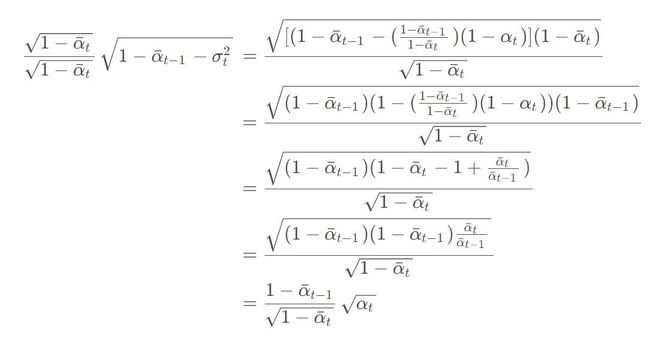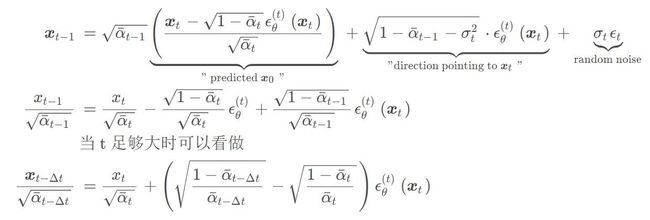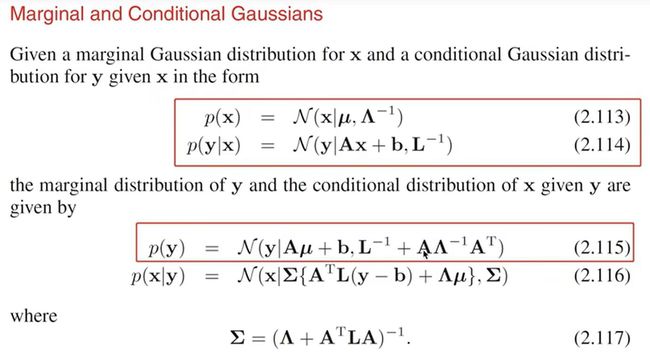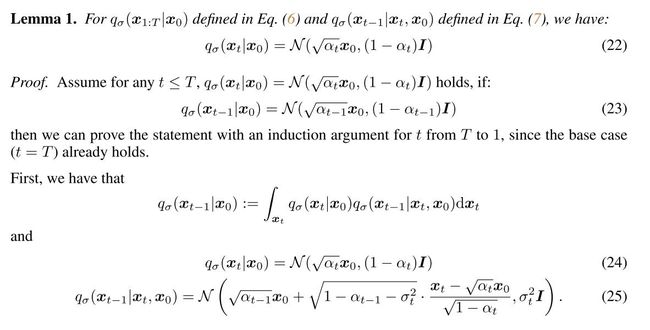【DDIM加速采样方法】公式推导加代码分析。Denoising Diffusion Implicit Models
【DDIM加速采样方法】公式推导加代码分析。Denoising Diffusion Implicit Models
- 1.前言:
-
- ddim总览
- 2.均值( μ \mu μ)
- 3.方差( σ \sigma σ)
- 4.证明部分
-
- 一、论文中公式(13)的推导:
- 二、在作者给定的公式中只说明 T 时刻满足与DDPM同样的 q ( X T ∣ X 0 ) q(X_T|X_0) q(XT∣X0), 但不能说明所有的 t 时刻,接下来就要证明:
- 5.respacing
- 6.代码分析:
-
- 一 、采样
- 二、respacing
- 7.Reference:
1.前言:
论文地址:https://arxiv.org/abs/2010.02502ICLR 2021
项目地址:https://github.com/openai/improved-diffusion
不啰嗦,就简单介绍采样过程的均值与方差的推导。
训练过程与DDPM差不多。
证明部分放在最后。
请注意,DDIM 论文中的 α t \alpha_t αt 是指来自 DDPM 的 α ˉ t {\color{lightgreen}\bar\alpha_t} αˉt。
其中 ϵ τ i \epsilon_{\tau_i} ϵτi 是随机噪声, τ \tau τ 是 [ 1 , 2 , … , T ] [1,2,\dots,T] [1,2,…,T] 的子序列,长度为 S S S,
DDPM的均值方差及公式推导看这篇:https://blog.csdn.net/qq_45934285/article/details/129107994?spm=1001.2014.3001.5501(DDPM是前置知识需要先看)
ddim总览
- 不同于 DDPM 基于马尔可夫的 Forward Process,DDIM 提出了 NON-MARKOVIAN FForward Processes。
- 基于这一假设,DDIM 推导出了相比于 DDPM 更快的采样过程。
- 相比于 DDPM,DDIM 的采样是确定的,即给定了同样的初始噪声 x t x_t xt ,DDIM 能够生成相同的结果 x 0 x_0 x0 。
- DDIM和DDPM的训练方法相同,因此在 DDPM 基础上加上 DDIM 采样方案即可。
2.均值( μ \mu μ)
x τ i − 1 = α τ i − 1 ( x τ i − 1 − α τ i ϵ θ ( x τ i ) α τ i ) + 1 − α τ i − 1 − σ τ i 2 ⋅ ϵ θ ( x τ i ) + σ τ i ϵ τ i x_{\tau_{i-1}} = \sqrt{\alpha_{\tau_{i-1}}}\Bigg( \frac{x_{\tau_i} - \sqrt{1 - \alpha_{\tau_i}}\epsilon_\theta(x_{\tau_i})}{\sqrt{\alpha_{\tau_i}}} \Bigg) \\ + \sqrt{1 - \alpha_{\tau_{i- 1}} - \sigma_{\tau_i}^2} \cdot \epsilon_\theta(x_{\tau_i}) \\ + \sigma_{\tau_i} \epsilon_{\tau_i} xτi−1=ατi−1(ατixτi−1−ατiϵθ(xτi))+1−ατi−1−στi2⋅ϵθ(xτi)+στiϵτi

主公式是公式(7),然后由公式(10)(9)得到最终的均值表达式

其中predicted x0部分就是将DDPM的x0的由xt和噪声的表达。
direction pointing to xt部分也是将上一步的x0代入公式(7)得到的结果。

损失函数:

3.方差( σ \sigma σ)
σ τ i = η 1 − α τ i − 1 1 − α τ i 1 − α τ i α τ i − 1 \sigma_{\tau_i} = \eta \sqrt{\frac{1 - \alpha_{\tau_{i-1}}}{1 - \alpha_{\tau_i}}} \sqrt{1 - \frac{\alpha_{\tau_i}}{\alpha_{\tau_{i-1}}}} στi=η1−ατi1−ατi−11−ατi−1ατi

这里考虑两种特殊情况:
如果 η = 0 \eta = 0 η=0,那么生成过程就是确定的,这种情况下为 DDIM。
如果 η = 1 \eta = 1 η=1,该前向过程变成了马尔科夫链,该生成过程等价于 DDPM 的生成过程。也就是说==当 η = 1 \eta = 1 η=1的时候,采样公式(均值)变为DDPM的采样公式。即:

将 η = 1 \eta = 1 η=1的方差公式代入到上面的均值公式中能够得到(DDPM采样公式):

证明先看:

证明:

得到上面这个结论然后代入均值公式:

4.证明部分
一、论文中公式(13)的推导:

而后进行换元,令 σ = ( 1 − α ˉ / α ˉ ) \sigma=(\sqrt{1-\bar\alpha}/\sqrt{\bar\alpha}) σ=(1−αˉ/αˉ), x ˉ = x / α ˉ \bar x = x/\sqrt{\bar\alpha} xˉ=x/αˉ ,带入得到:

于是,基于这个 ODE 结果,能通过 x ˉ ( t ) + d x ˉ ( t ) \bar x({t}) + d\bar x(t) xˉ(t)+dxˉ(t)计算得到 x ˉ ( t + 1 ) \bar x(t+1) xˉ(t+1)与 x t + 1 x_{t+1} xt+1
二、在作者给定的公式中只说明 T 时刻满足与DDPM同样的 q ( X T ∣ X 0 ) q(X_T|X_0) q(XT∣X0), 但不能说明所有的 t 时刻,接下来就要证明:
前置知识:

回顾一下数学归纳法:


此时我们知道T时刻满足条件,首先假设t时刻也满足条件,那么如果t-1时刻也满足条件,即命题得证!


5.respacing
respacing是一种加速采样的技巧。
训练可以是一个长序列,而采样可以只在子序列上进行。
6.代码分析:
代码来自文章开头的项目地址IDDPM。
一 、采样
采样函数:
def ddim_sample(
self,
model,
x,
t,
clip_denoised=True,
denoised_fn=None,
model_kwargs=None,
eta=0.0,
):
"""
Sample x_{t-1} from the model using DDIM.
Same usage as p_sample().
"""
out = self.p_mean_variance(
model,
x,
t,
clip_denoised=clip_denoised,
denoised_fn=denoised_fn,
model_kwargs=model_kwargs,
)
# Usually our model outputs epsilon, but we re-derive it
# in case we used x_start or x_prev prediction.
eps = self._predict_eps_from_xstart(x, t, out["pred_xstart"])
alpha_bar = _extract_into_tensor(self.alphas_cumprod, t, x.shape)
alpha_bar_prev = _extract_into_tensor(self.alphas_cumprod_prev, t, x.shape)
sigma = (
eta
* th.sqrt((1 - alpha_bar_prev) / (1 - alpha_bar))
* th.sqrt(1 - alpha_bar / alpha_bar_prev)
)
# Equation 12.
noise = th.randn_like(x)
mean_pred = (
out["pred_xstart"] * th.sqrt(alpha_bar_prev)
+ th.sqrt(1 - alpha_bar_prev - sigma ** 2) * eps
)
nonzero_mask = (
(t != 0).float().view(-1, *([1] * (len(x.shape) - 1)))
) # no noise when t == 0
sample = mean_pred + nonzero_mask * sigma * noise
return {"sample": sample, "pred_xstart": out["pred_xstart"]}
反向过程:
def ddim_reverse_sample(
self,
model,
x,
t,
clip_denoised=True,
denoised_fn=None,
model_kwargs=None,
eta=0.0,
):
"""
Sample x_{t+1} from the model using DDIM reverse ODE.
"""
assert eta == 0.0, "Reverse ODE only for deterministic path"
out = self.p_mean_variance(
model,
x,
t,
clip_denoised=clip_denoised,
denoised_fn=denoised_fn,
model_kwargs=model_kwargs,
)
# Usually our model outputs epsilon, but we re-derive it
# in case we used x_start or x_prev prediction.
eps = (
_extract_into_tensor(self.sqrt_recip_alphas_cumprod, t, x.shape) * x
- out["pred_xstart"]
) / _extract_into_tensor(self.sqrt_recipm1_alphas_cumprod, t, x.shape)
alpha_bar_next = _extract_into_tensor(self.alphas_cumprod_next, t, x.shape)
# Equation 12. reversed
mean_pred = (
out["pred_xstart"] * th.sqrt(alpha_bar_next)
+ th.sqrt(1 - alpha_bar_next) * eps
)
return {"sample": mean_pred, "pred_xstart": out["pred_xstart"]}
循环采样:
def ddim_sample_loop(
self,
model,
shape,
noise=None,
clip_denoised=True,
denoised_fn=None,
model_kwargs=None,
device=None,
progress=False,
eta=0.0,
):
"""
Generate samples from the model using DDIM.
Same usage as p_sample_loop().
"""
final = None
for sample in self.ddim_sample_loop_progressive(
model,
shape,
noise=noise,
clip_denoised=clip_denoised,
denoised_fn=denoised_fn,
model_kwargs=model_kwargs,
device=device,
progress=progress,
eta=eta,
):
final = sample
return final["sample"]
采样主体:
def ddim_sample_loop_progressive(
self,
model,
shape,
noise=None,
clip_denoised=True,
denoised_fn=None,
model_kwargs=None,
device=None,
progress=False,
eta=0.0,
):
"""
Use DDIM to sample from the model and yield intermediate samples from
each timestep of DDIM.
Same usage as p_sample_loop_progressive().
"""
if device is None:
device = next(model.parameters()).device
assert isinstance(shape, (tuple, list))
if noise is not None:
img = noise
else:
img = th.randn(*shape, device=device)
indices = list(range(self.num_timesteps))[::-1]
if progress:
# Lazy import so that we don't depend on tqdm.
from tqdm.auto import tqdm
indices = tqdm(indices)
for i in indices:
t = th.tensor([i] * shape[0], device=device)
with th.no_grad():
out = self.ddim_sample(
model,
img,
t,
clip_denoised=clip_denoised,
denoised_fn=denoised_fn,
model_kwargs=model_kwargs,
eta=eta,
)
yield out
img = out["sample"]
二、respacing
整个代码:代码中有注释!!!
import numpy as np
import torch as th
from .gaussian_diffusion import GaussianDiffusion
def space_timesteps(num_timesteps, section_counts):
"""
Create a list of timesteps to use from an original diffusion process,
given the number of timesteps we want to take from equally-sized portions
of the original process.
For example, if there's 300 timesteps and the section counts are [10,15,20]
then the first 100 timesteps are strided to be 10 timesteps, the second 100
are strided to be 15 timesteps, and the final 100 are strided to be 20.
If the stride is a string starting with "ddim", then the fixed striding
from the DDIM paper is used, and only one section is allowed.
:param num_timesteps: the number of diffusion steps in the original
process to divide up.
:param section_counts: either a list of numbers, or a string containing
comma-separated numbers, indicating the step count
per section. As a special case, use "ddimN" where N
is a number of steps to use the striding from the
DDIM paper.
:return: a set of diffusion steps from the original process to use.
"""
if isinstance(section_counts, str):
if section_counts.startswith("ddim"):
desired_count = int(section_counts[len("ddim") :])
for i in range(1, num_timesteps):
if len(range(0, num_timesteps, i)) == desired_count:
return set(range(0, num_timesteps, i))
raise ValueError(
f"cannot create exactly {num_timesteps} steps with an integer stride"
)
section_counts = [int(x) for x in section_counts.split(",")]
size_per = num_timesteps // len(section_counts)
extra = num_timesteps % len(section_counts)
start_idx = 0
all_steps = []
for i, section_count in enumerate(section_counts):
size = size_per + (1 if i < extra else 0)
if size < section_count:
raise ValueError(
f"cannot divide section of {size} steps into {section_count}"
)
if section_count <= 1:
frac_stride = 1
else:
frac_stride = (size - 1) / (section_count - 1)
cur_idx = 0.0
taken_steps = []
for _ in range(section_count):
taken_steps.append(start_idx + round(cur_idx))
cur_idx += frac_stride
all_steps += taken_steps
start_idx += size
return set(all_steps)
class SpacedDiffusion(GaussianDiffusion):
"""
A diffusion process which can skip steps in a base diffusion process.
:param use_timesteps: a collection (sequence or set) of timesteps from the
original diffusion process to retain.
:param kwargs: the kwargs to create the base diffusion process.
"""
def __init__(self, use_timesteps, **kwargs):
self.use_timesteps = set(use_timesteps)# 指可以用的时间步,可能是步长为1,也有可能步长大于1(respacing)
self.timestep_map = []# 基本等同于use_timesteps,不过是列表
self.original_num_steps = len(kwargs["betas"])
base_diffusion = GaussianDiffusion(**kwargs) # pylint: disable=missing-kwoa
# 计算全新采样时刻后的betas
last_alpha_cumprod = 1.0
# 重新定义betas序列
new_betas = []
for i, alpha_cumprod in enumerate(base_diffusion.alphas_cumprod):
if i in self.use_timesteps:
# 来自beta与alpha之间的关系式
new_betas.append(1 - alpha_cumprod / last_alpha_cumprod)
last_alpha_cumprod = alpha_cumprod
self.timestep_map.append(i)
# 更新self.betas成员变量
kwargs["betas"] = np.array(new_betas)# 此处更新了betas
super().__init__(**kwargs)
def p_mean_variance(
self, model, *args, **kwargs
): # pylint: disable=signature-differs
return super().p_mean_variance(self._wrap_model(model), *args, **kwargs)
def training_losses(
self, model, *args, **kwargs
): # pylint: disable=signature-differs
return super().training_losses(self._wrap_model(model), *args, **kwargs)
def _wrap_model(self, model):
if isinstance(model, _WrappedModel):
return model
return _WrappedModel(
model, self.timestep_map, self.rescale_timesteps, self.original_num_steps
)
def _scale_timesteps(self, t):
# Scaling is done by the wrapped model.
return t
class _WrappedModel:
def __init__(self, model, timestep_map, rescale_timesteps, original_num_steps):
self.model = model
self.timestep_map = timestep_map
self.rescale_timesteps = rescale_timesteps
self.original_num_steps = original_num_steps
def __call__(self, x, ts, **kwargs):
# ts是连续的索引,map_tensor中包含的是spacing后的索引
# __call__的作用是将ts映射到真正的spacing后的时间步骤
map_tensor = th.tensor(self.timestep_map, device=ts.device, dtype=ts.dtype)
new_ts = map_tensor[ts]
if self.rescale_timesteps:
# 始终控制new_ts在[0,1000]以内的浮点数
new_ts = new_ts.float() * (1000.0 / self.original_num_steps)
return self.model(x, new_ts, **kwargs)
至此结束,感谢阅读^ - ^!
如果觉得有帮助的话,希望点赞收藏评论加关注支持一下吧。
你的支持是我创作的最大动力!!!
7.Reference:
1.https://blog.csdn.net/m0_63642362/article/details/128593528?ops_request_misc=&request_id=&biz_id=102&utm_term=ddim&utm_medium=distribute.pc_search_result.none-task-blog-2allsobaiduweb~default-1-128593528.142v75insert_down38,201v4add_ask,239v2insert_chatgpt&spm=1018.2226.3001.4187
2.https://www.bilibili.com/video/BV1JY4y1N7dn/?spm_id_from=333.999.0.0&vd_source=5413f4289a5882463411525768a1ee27
3.https://blog.csdn.net/weixin_43850253/article/details/128413786?ops_request_misc=%257B%2522request%255Fid%2522%253A%2522167945157616800222855326%2522%252C%2522scm%2522%253A%252220140713.130102334…%2522%257D&request_id=167945157616800222855326&biz_id=0&utm_medium=distribute.pc_search_result.none-task-blog-2alltop_click~default-2-128413786-null-null.142v75insert_down38,201v4add_ask,239v2insert_chatgpt&utm_term=ddim&spm=1018.2226.3001.4187




